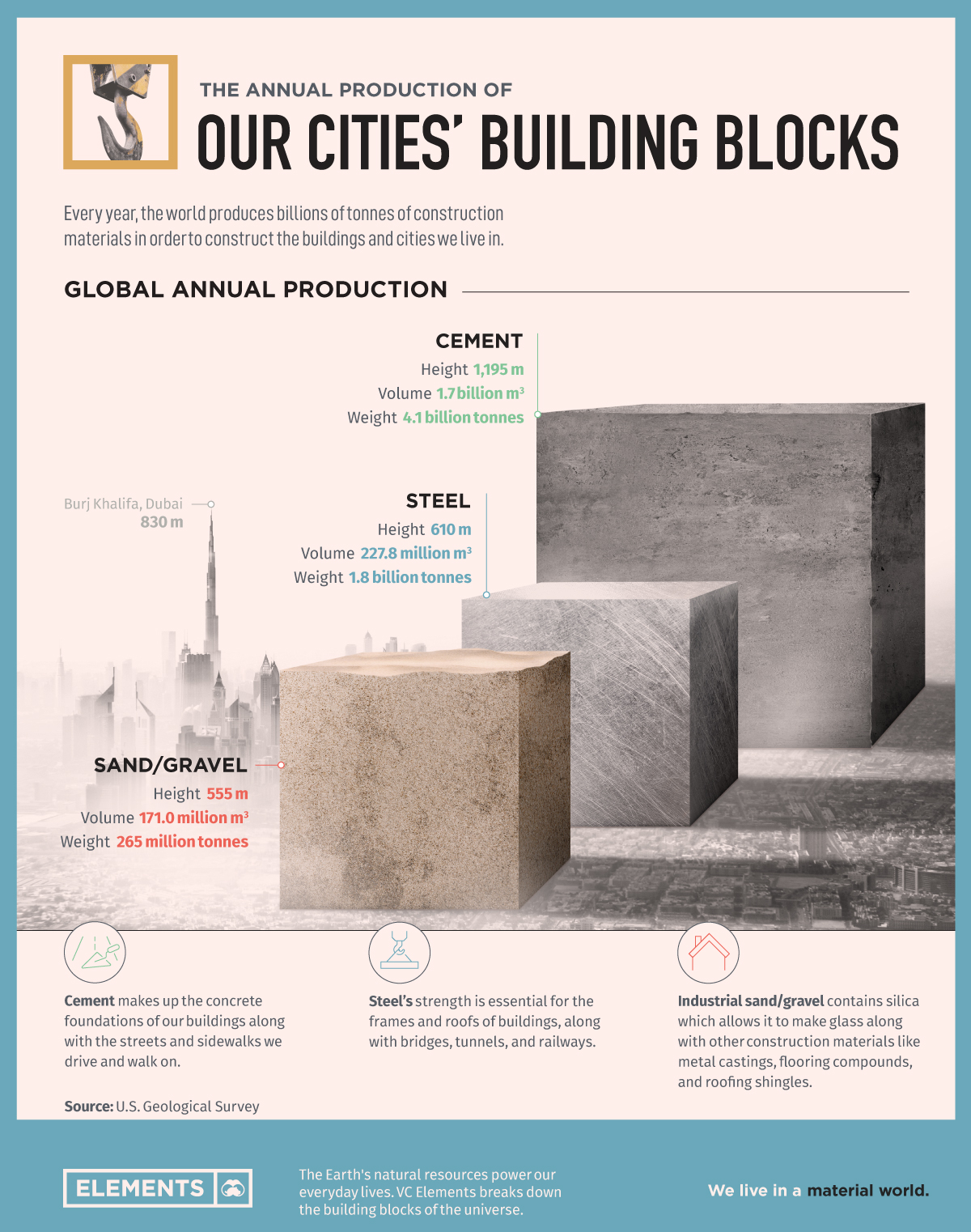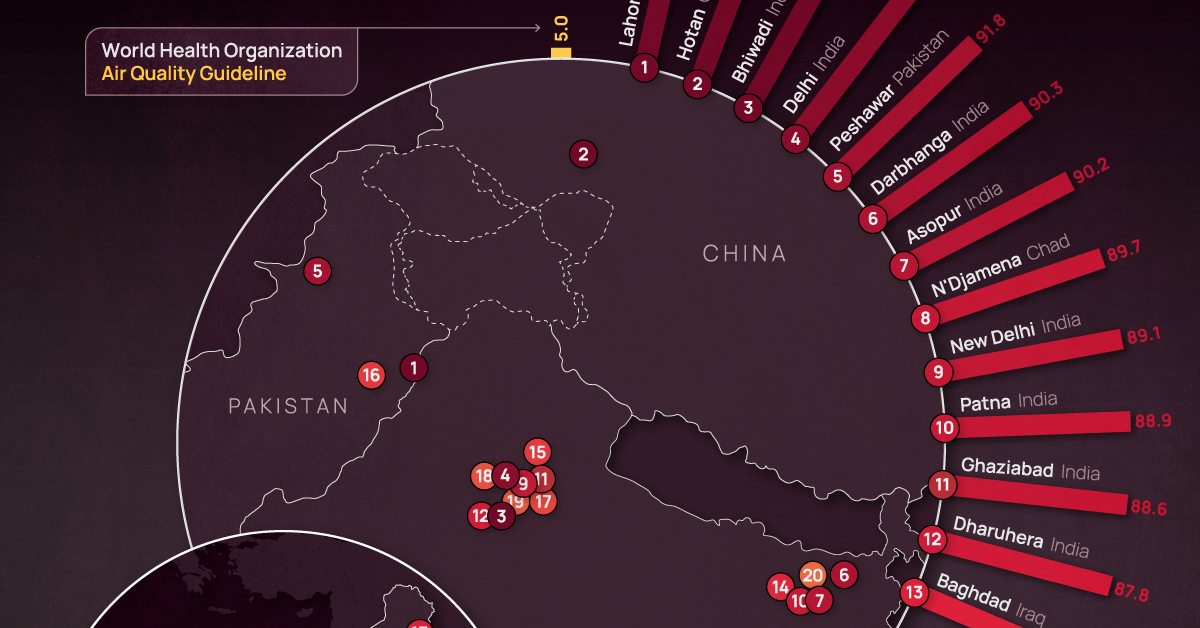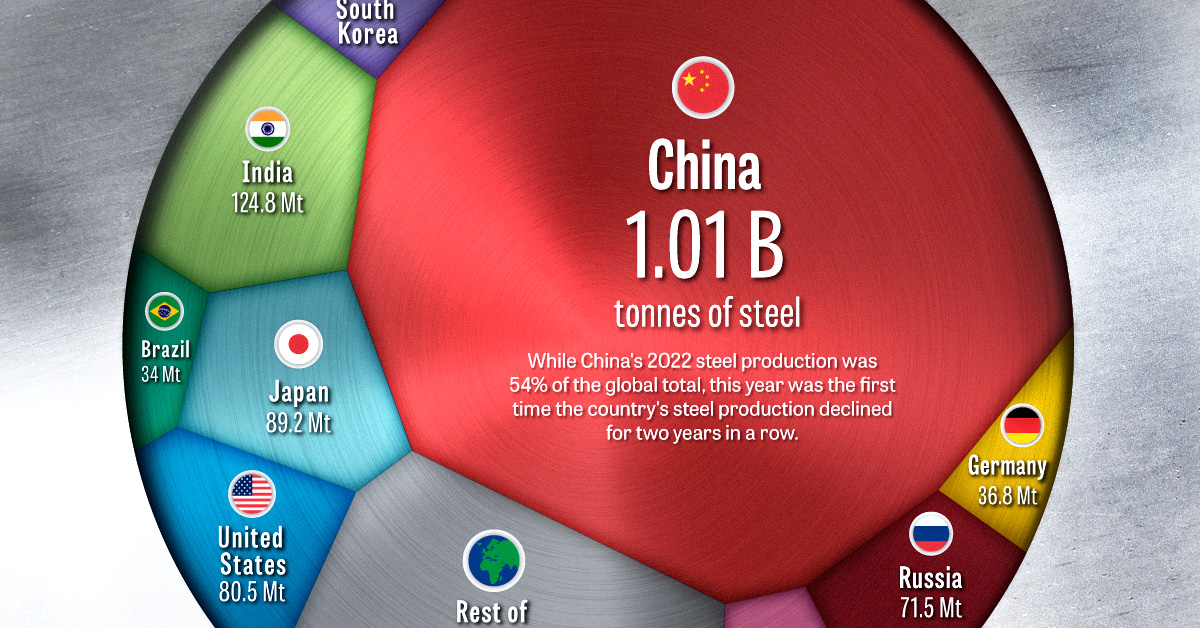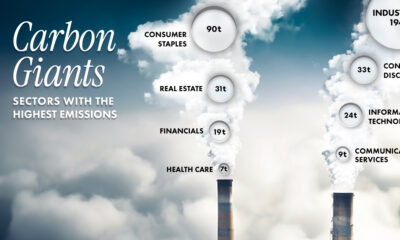Urbanization
Sand, Steel, and Cement: The Annual Production of the World’s Building Blocks

Essential Materials for City Construction
From the buildings around us to the sidewalks we walk on, sand, steel, and cement are an important foundation for all urbanization. Every year, the world produces an immense amount of all three materials in order to supply the continuous construction of human-built environments around the world.
Using data from the U.S. Geological Survey, this visualization shows the steel, sand, and cement produced in 2020, to help put in perspective the amount of raw materials we produce and ultimately consume every year.
The Concrete Facts of Cement
Cement is the indispensable glue that binds together the materials that make up concrete highways, sidewalks, and buildings.
With concrete being the world’s most consumed material (beaten only by water), it’s no wonder that the world produced 4.1 billion tonnes of cement in 2020.
2020 Cement Production by Country
| Rank | Country | Cement Production (in million tonnes) |
|---|---|---|
| #1 | 🇨🇳 China | 2,200 |
| #2 | 🇮🇳 India | 340 |
| #3 | 🇻🇳 Vietnam | 96 |
| #4 | 🇺🇸 United States | 90 |
| #5 | 🇮🇩 Indonesia | 73 |
| #6 | 🇹🇷 Turkey | 66 |
| #7 | 🇮🇷 Iran | 60 |
| #8 | 🇧🇷 Brazil | 57 |
| #9 | 🇷🇺 Russia | 56 |
| #10 | 🇯🇵 Japan | 53 |
| #11 | 🇪🇬 Egypt | 50 |
| #12 | 🇰🇷 South Korea | 50 |
| Other countries | 890 |
Source: USGS
While cement-based concrete has a variety of benefits like being fire-proof, hydrographic, and frost-resistant, the IEA estimates that in 2019 the cement sector emitted 2.4 GtCO2, which accounted for 7% of global CO2 emissions. The production of concrete also requires high amounts of water, with calculations from 2012 finding that the concrete industry’s water withdrawals made up 9% of all industry water withdrawals (1.7% of total global water withdrawal).
To combat high carbon emissions and water consumption in concrete production, Swedish power company Vattenfall has developed a concrete mix which reduces the amount of cement needed, and as a result cuts down CO2 emissions by around 25%. Shifting the world’s concrete production to this new method could be the first step in greatly reducing cement and concrete’s impact on the environment.
Steel Recyclability Steals the Show
While cement is the most commonly used material in the world, steel is the most commonly used metal. With 1.8 billion tonnes produced last year, steel fulfills a variety of structural and construction needs, along with being an essential material for the production of vehicles, mechanical equipment, and domestic appliances.
One of steel’s greatest strengths is its ability to be infinitely recycled, making it the most recycled material in the world with new steel products containing an average of 30% recycled steel. While the world produced 1.8 billion tonnes of steel in 2020, since 1900 the steel industry has recycled over 25 billion tonnes of steel scrap, reducing iron ore and coal consumption by 35 billion and 18 billion tonnes respectively.
Global Steel Recovery Rates by Sector
| Sector | Steel Recovery Rate |
|---|---|
| Automotive | 90% |
| Machinery | 90% |
| Construction | 85% |
| Electrical and domestic appliances | 50% |
Source: World Steel Association
The steel industry is also highly aware of reducing its environmental impact, with steel plants reusing the heat and electricity from process gases to provide between 60-100% of the plant’s electricity requirements. Along with this, ~90% of water used by the steel industry is returned to the source after being cleaned and cooled.
Yet steel production still emits around two tonnes of CO2 for every tonne of steel produced, largely due to the majority of the world’s steel production taking place in China’s coal-reliant plants. However, fossil-free steel is on the horizon, with carmaker Volvo partnering with the Swedish steelmakers SSAB to explore the development of fossil-free steel for the automotive industry.
More than Beaches
Completing the trio of essential city-building materials is industrial sand and gravel, with 265 million tonnes of the material produced in 2020. Primarily composed of quartz, feldspar, and other minerals and rock fragments, industrial sand and gravel is also called silica sand or quartz sand.
“It’s actually the most important solid substance in the world because without sand, we have no modern civilization.”
– Vince Beiser
While steel and cement are opaquely visible in their end products in our cities, industrial sand and gravel primarily makes up the transparent glass walls and windows of our world. It also serves essential functions as foundry sand, forming molds and patterns for various metal castings.
Just like steel and cement, industrial sand and gravel is an essential building block of the cities we live in. As the world continues its shift towards reducing carbon emissions, it is clear that these essential materials cannot be replaced, and rather must be improved upon.
Urbanization
Ranked: The 20 Most Air-Polluted Cities on Earth
Using 2022 average PM2.5 concentrations, we rank the most polluted cities in the world.

Ranked: The 20 Most Air-Polluted Cities on Earth
According to the World Health Organization (WHO), almost the entire global population (99%) breathes air that exceeds WHO air quality limits.
In the above map, we use 2022 average PM2.5 concentrations from IQAir’s World Air Quality Report to visualize the most air-polluted major cities in the world.
World’s Air Pollution Hot Spots
As one of the standard air quality indicators used by the WHO, the PM2.5 concentration refers to the quantity of fine particulate matter with a diameter of 2.5 micrometers or less in a given volume of air.
Fine particulate matter that is this small can penetrate the lungs when inhaled and enter the bloodstream, affecting all major organs.
Based on annual average PM2.5 concentrations (μg/m³) in 2022, here are the most polluted cities in the world.
| Rank | City | 2022 average PM2.5 concentration (μg/m³) |
|---|---|---|
| 1 | 🇵🇰 Lahore, Pakistan | 97.4 |
| 2 | 🇨🇳 Hotan, China | 94.3 |
| 3 | 🇮🇳 Bhiwadi, India | 92.7 |
| 4 | 🇮🇳 Delhi, India | 92.6 |
| 5 | 🇵🇰 Peshawar, Pakistan | 91.8 |
| 6 | 🇮🇳 Darbhanga, India | 90.3 |
| 7 | 🇮🇳 Asopur, India | 90.2 |
| 8 | 🇹🇩 N'Djamena, Chad | 89.7 |
| 9 | 🇮🇳 New Delhi, India | 89.1 |
| 10 | 🇮🇳 Patna, India | 88.9 |
| 11 | 🇮🇳 Ghaziabad, India | 88.6 |
| 12 | 🇮🇳 Dharuhera, India | 87.8 |
| 13 | 🇮🇶 Baghdad, Iraq | 86.7 |
| 14 | 🇮🇳 Chapra, India | 85.9 |
| 15 | 🇮🇳 Muzaffarnagar, India | 85.5 |
| 16 | 🇵🇰 Faisalabad, Pakistan | 84.5 |
| 17 | 🇮🇳 Greater Noida, India | 83.2 |
| 18 | 🇮🇳 Bahadurgarh, India | 82.2 |
| 19 | 🇮🇳 Faridabad, India | 79.7 |
| 20 | 🇮🇳 Muzaffarpur, India | 79.2 |
With numbers these high, the concentration of some or all of the following pollutants are at dangerous levels in these cities:
- Ground-level ozone
- Particulate matter
- Carbon monoxide
- Sulfur dioxide
- Nitrogen dioxide
At the top of the list, Lahore in Pakistan has a combination of high vehicle and industrial emissions, as well as smoke from brick kilns, crop residue, general waste burning, and dust from construction sites.
Air pollution levels can also be impacted by practices such as large-scale tree removal in order to build new roads and buildings.
As a result of its growing population and rapidly expanding industrial sector, India has 14 cities on the list, outpacing China, formerly considered the world’s number one air pollution source.
The only African country on the list, Chad, experienced severe dust storms in 2022 that resulted in an 18% increase in PM2.5 concentration in 2022 compared to the previous year.
The Cost of Poor Air Quality
Poor air quality is one of the leading causes of early deaths worldwide, just behind high blood pressure, tobacco use, and poor diet.
According to a 2020 study by the Health Effects Institute, 6.67 million people died as a result of air pollution in 2019.
In addition to the millions of premature deaths each year, the global cost of health damages associated with air pollution currently sits at $8.1 trillion.
Urbanization
Visualizing the World’s Largest Steel-Producing Countries
China has dominated global steel production the past few decades, but how did the country get here, and is its production growth over?

The Largest Steel-Producing Countries: Visualized
Steel is a critical component of modern industry and economy, essential for the construction of buildings, automobiles, and many other appliances and infrastructure used in our daily lives.
This graphic uses data from the World Steel Association to visualize the world’s top steel-producing countries, and highlights China’s ascent to the top, as it now makes up more than half of the world’s steel production.
The State of Global Steel Production
Global steel production in 2022 reached 1,878 million tonnes, barely surpassing the pre-pandemic production of 1,875 million tonnes in 2019.
| Country | 2022 Production (in million tonnes) | Annual Production Change | Global Share |
|---|---|---|---|
| 🇨🇳 China | 1013.0 | -2.0% | 53.9% |
| 🇮🇳 India | 124.8 | 5.3% | 6.6% |
| 🇯🇵 Japan | 89.2 | -7.9% | 4.8% |
| 🇺🇸 United States | 80.5 | -6.5% | 4.3% |
| 🇷🇺 Russia | 71.5 | -5.8% | 3.8% |
| 🇰🇷 South Korea | 65.9 | -6.9% | 3.5% |
| 🇩🇪 Germany | 36.8 | -8.8% | 2.0% |
| 🇹🇷 Türkiye | 35.1 | -15.0% | 1.9% |
| 🇧🇷 Brazil | 34.0 | -6.5% | 1.8% |
| 🇮🇷 Iran | 30.6 | 6.8% | 1.6% |
| 🇮🇹 Italy | 21.6 | -13.0% | 1.1% |
| 🇹🇼 Taiwan | 20.7 | -12.1% | 1.1% |
| 🇻🇳 Vietnam | 20.0 | -15.0% | 1.1% |
| 🇲🇽 Mexico | 18.2 | -1.9% | 1.0% |
| 🇮🇩 Indonesia | 15.6 | 8.3% | 0.8% |
| Rest of World | 201.0 | -11.2% | 10.7% |
| World Total | 1878.5 | -3.9% | 100.0% |
2022’s steel production marked a significant reduction compared to the post-pandemic rebound of 1,960 million tonnes in 2021, with a year-over-year decline of 4.2%–the largest drop since 2009, and prior to that, 1991.
This decline was spread across many of the world’s top steel producers, with only three of the top fifteen countries, India, Iran, and Indonesia, increasing their yearly production. Most of the other top steel-producing countries saw annual production declines of more than 5%, with Turkey, Italy, Taiwan, and Vietnam’s production all declining by double digits.
Even the world’s top steel-producing nation, China, experienced a modest 2% decline, which due to the country’s large production amounted to a decline of 19.8 million tonnes, more than many other nations produce in a year.
Despite India, the world’s second-largest steel producer, increasing its production by 5.3%, the country’s output still amounts to just over one-tenth of the steel produced by China.
China’s Meteoric Rise in Steel Production
Although China dominates the world’s steel production with more than a 54% share today, this hasn’t always been the case.
In 1967, the World Steel Association’s first recorded year of steel production figures, China only produced an estimated 14 million tonnes, making up barely 3% of global output. At that time, the U.S. and the USSR were competing as the world’s top steel producers at 115 and 102 million tonnes respectively, followed by Japan at 62 million tonnes.
Almost three decades later in 1996, China had successively overtaken Russia, the U.S., and Japan to become the top steel-producing nation with 101 million tonnes of steel produced that year.
The early 2000s marked a period of rapid growth for China, with consistent double-digit percentage increases in steel production each year.
The Recent Decline in China’s Steel Production
Since the early 2000s, China’s average annual growth in steel production has slowed to 3.4% over the last decade (2013-2022), a considerable decline compared to the previous decade’s (2003-2012) 15.2% average annual growth rate.
The past couple of years have seen China’s steel production decline, with 2021 and 2022 marking the first time the country’s production fell for two consecutive years in a row.
While it’s unlikely China will relinquish its position as the top steel-producing nation anytime soon, it remains to be seen whether this recent decline marks the beginning of a new trend or just a brief deviation from the country’s consistent production growth.
-

 Electrification3 years ago
Electrification3 years agoRanked: The Top 10 EV Battery Manufacturers
-

 Electrification2 years ago
Electrification2 years agoThe Key Minerals in an EV Battery
-

 Real Assets3 years ago
Real Assets3 years agoThe World’s Top 10 Gold Mining Companies
-

 Misc3 years ago
Misc3 years agoAll the Metals We Mined in One Visualization
-

 Electrification3 years ago
Electrification3 years agoThe Biggest Mining Companies in the World in 2021
-

 Energy Shift2 years ago
Energy Shift2 years agoWhat Are the Five Major Types of Renewable Energy?
-

 Electrification2 years ago
Electrification2 years agoMapped: Solar Power by Country in 2021
-

 Electrification2 years ago
Electrification2 years agoThe World’s Largest Nickel Mining Companies






















